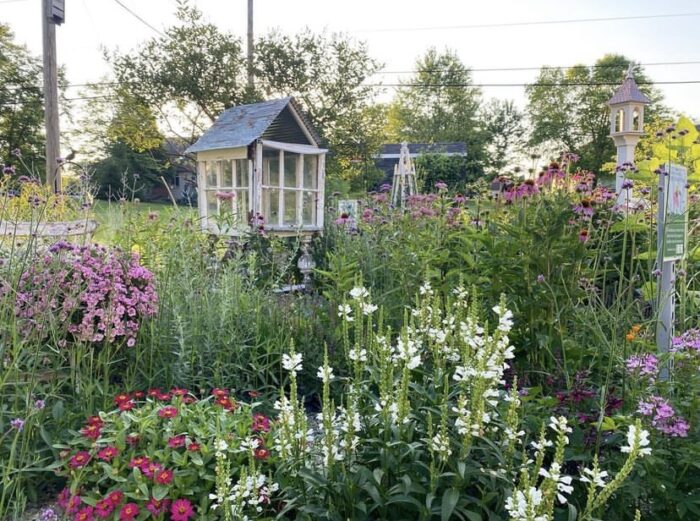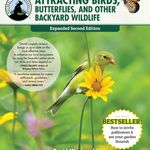
I’m Katie. I’m a proud Midwesterner, and all of these photos are from my Indiana backyard garden. By day, I am a licensed and certified speech-language pathologist. By weekend and summer, I turn full-fledged gardener and spend most of my time in my humble backyard paradise.
About six years ago, I began transforming our empty, desolate, almost full-acre yard to rich, healthy ecosystems in the form of garden beds, shrubs, and trees. In addition to this, I “raise” monarchs and proudly wear the title of a bird nerd landlord. I’ve raised hundreds of monarchs over the last few summers and successfully hosted dozens of broods of native birds, including robins, eastern bluebirds, chickadees, swallowtails, and wrens. I am incredibly passionate about demonstrating how to have beautiful gardens that serve our wildlife and strive to be proof that you can have gardens for both you and the ecosystem to simultaneously enjoy.
It’s traditionally thought that native gardens look wild, messy, and weedy. I enjoy sharing with others how to have aesthetically appealing gardens that not only suit our eye but provide essential nutrients, shelter, habitat, and life-cycle support to everything from tiny insects to our biggest backyard visitors. This can be done with intentional gardening through clean edges, placement of plants, and designated educational signage.
I am most proud of the change that this yard has endured. Going from what previously was one mature crabapple tree (Malus sp., Zones 4–9) and some mature silver maples (Acer saccharinum, Zones 3–9) along the side and front, this yard now has five more trees: a red oak (Quercus rubra, Zones 4–8), tulip poplar (Liriodendron tulipifera, Zones 4–9), blue spruce (Picea pungens, Zones 2–7), eastern redbud (Cercis canadensis, Zones 4–8), and river birch (Betula nigra, Zones 4–9). These were all chosen in an effort to return more natives to the area and support the insects and birds that rely on these trees for shelter and host food. Along with these trees, I’ve added five large garden beds. One bed has all berry shrubs for our birds. I call it “shrub row.” Another bed, which is my fall-interest bed, has native grasses, winterberry, goldenrod, a beautiful trellis that supports the native honeysuckle vine, and aster, to name a few. It is a beautiful focal point when everything else has faded.
Two of the largest beds are my mini-meadows. This is where I spend most of my time in the summer, soaking in the sights and sounds of the pollinators with either a coffee mug or a wine glass in hand. These spaces are home to so much life! Being that this yard is entirely chemical-free, the gardens are registered wildlife habitats, monarch waystations, award-winners for bringing natives home, and the best part: my true heaven on earth.
I’ve been part of several garden walks, and it just makes my heart beam when people visit and can truly hear and see (and learn!) about the things we can do right in our own gardens to help support our pollinators and birds.
Gardening wasn’t always easy for me. My first year, I did so much wrong! Like putting annuals in containers without drainage holes and not having enough soil in the pots. I continued to read, bought gardening books at garage sales, listened to seasoned gardeners, and attended free classes at Wild Birds Unlimited and local forest preserves. These events really helped further ignite my inner passion for gardening.
My hope for the future is that more people will consider planting natives in their yard space and rethink their heavy use of chemicals, insecticides, and sprays, which have such a significantly negative impact on our ecosystem. I love having encouraging conversations with others and enjoy helping guide people on where to begin. I’ve helped dozens of friends and family draw up, make, and plant their own gardens. It’s SO heartwarming when they tell me how much they enjoy it and wish they’d done it sooner.
I’ll keep sprinkling my passion showers wherever I can; I’ve helped put together our school garden, a pollinator garden in town, and now a tree effort where we will be planting 100 native trees. And I dream of wherever else this wonderful hobby of mine will take me!










If you want to see more from Katie, check out her instagram: @mylittlekatecod
Have a garden you’d like to share?
Have photos to share? We’d love to see your garden, a particular collection of plants you love, or a wonderful garden you had the chance to visit!
To submit, send 5-10 photos to gpod@taunton.com along with some information about the plants in the pictures and where you took the photos. We’d love to hear where you are located, how long you’ve been gardening, successes you are proud of, failures you learned from, hopes for the future, favorite plants, or funny stories from your garden.
Have a mobile phone? Tag your photos on Facebook, Instagram or Twitter with #FineGardening!
Do you receive the GPOD by email yet? Sign up here.
Fine Gardening Recommended Products

Attracting Beneficial Bugs to Your Garden, Revised and Updated Second Edition: A Natural Approach to Pest Control
Fine Gardening receives a commission for items purchased through links on this site, including Amazon Associates and other affiliate advertising programs.

National Wildlife Federation®: Attracting Birds, Butterflies, and Other Backyard Wildlife, Expanded Second Edition (Creative Homeowner) 17 Projects & Step-by-Step Instructions to Give Back to Nature
Fine Gardening receives a commission for items purchased through links on this site, including Amazon Associates and other affiliate advertising programs.

ARS Telescoping Long Reach Pruner
Fine Gardening receives a commission for items purchased through links on this site, including Amazon Associates and other affiliate advertising programs.


















Comments
So very, very pretty.
Oh wow, your garden must attract tons of hummingbirds too!
You are amazing- I wish there were more people like you in the world putting together gardens for school kids and in the town, planting 100s of trees, raising Monarchs....and LOL "Bird Nerd Landlord!"
It's beautiful and best of all chemical free! Great job!
Thank you for sharing your amazing garden and also your knowledge of how we can make our gardens better for wildlife. Nothing is more rewarding than seeing the birds come snd feed in our gardens. Your garden is just gorgeous. From Collingwood Ontario Canada
Love, love, love your garden!! Let's all keep spreading the gospel of planting for pollinators. We had so many butterflies, bees and moths this year as well as hummingbirds. People comment on it and ask how they can attract them, too.... but too many of them have "pest services" spraying their properties. Sigh...
Your beautiful gardens must bring huge smiles from every passerby when watching and hearing the beautiful wings flitter and flutter when the pollinators are gracefully gliding through the flowers, grasses and trees. Charming!
Log in or create an account to post a comment.
Sign up Log in